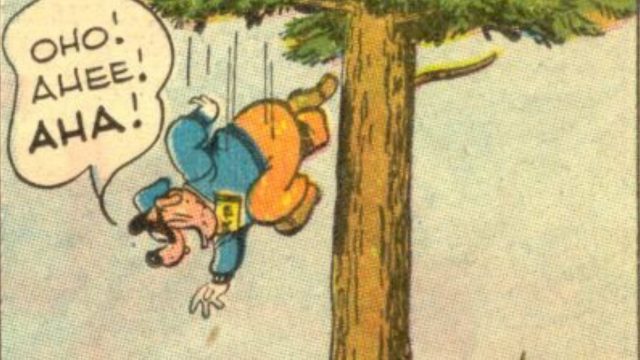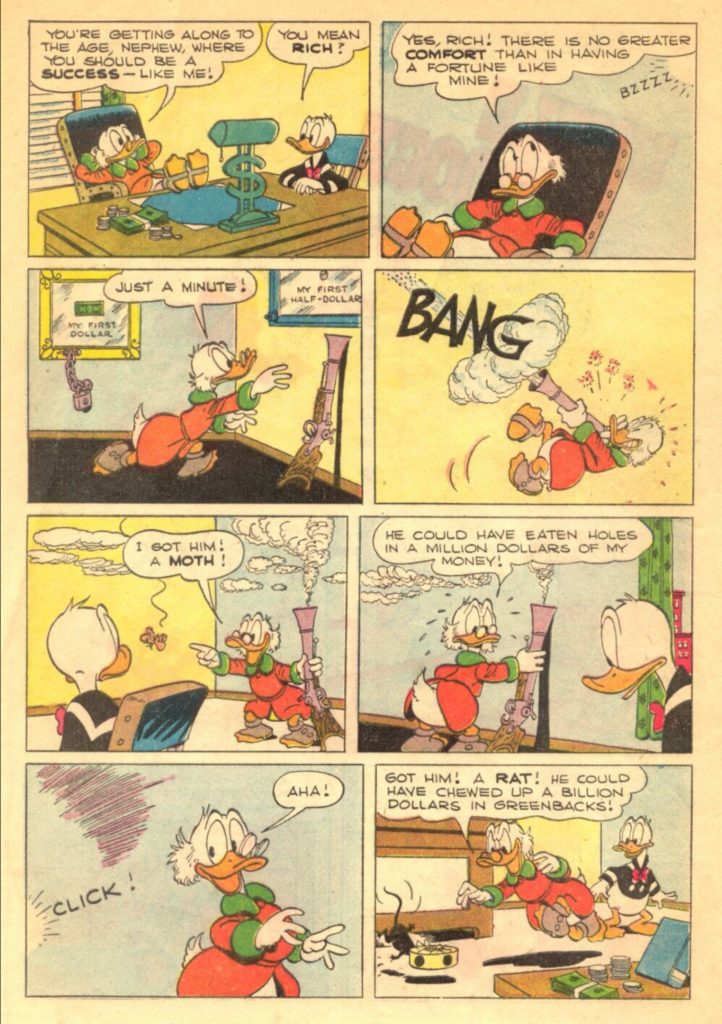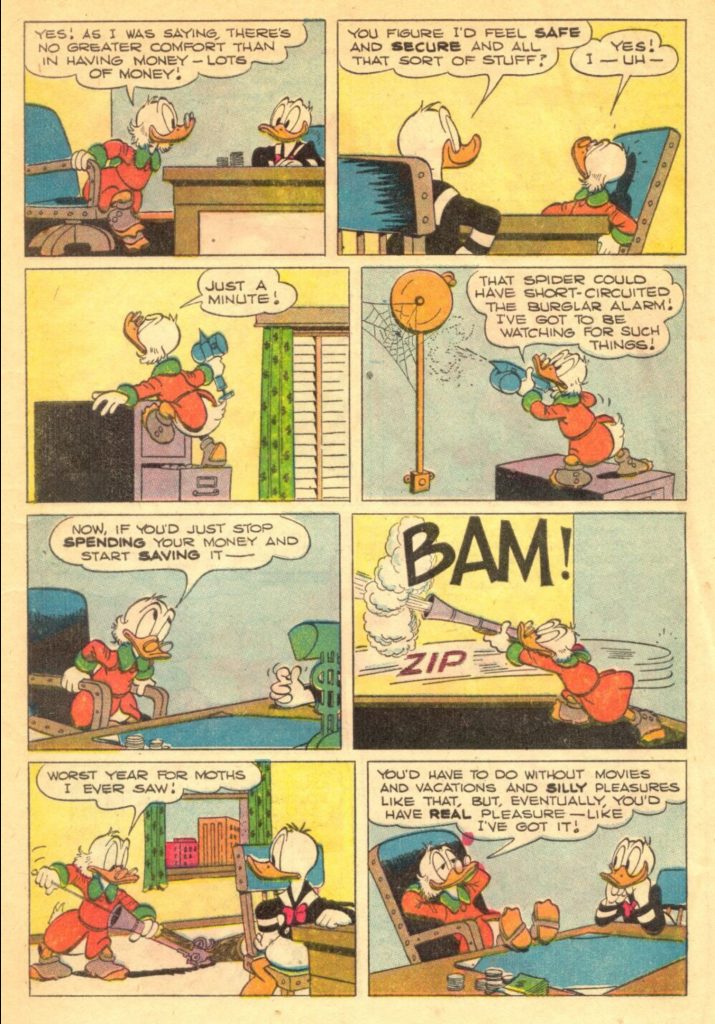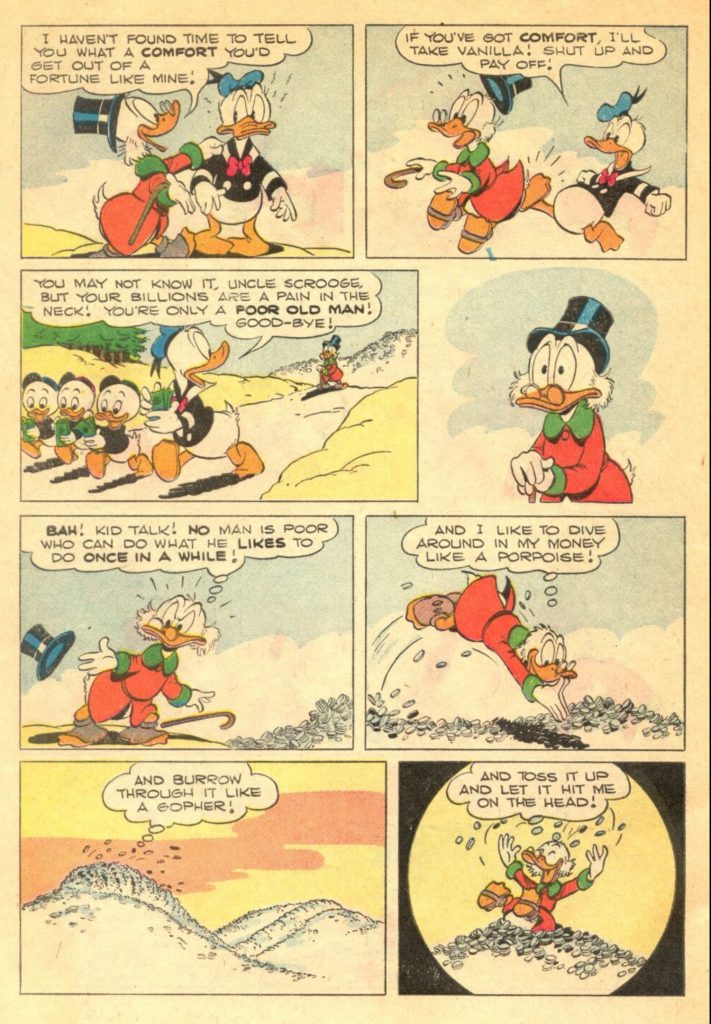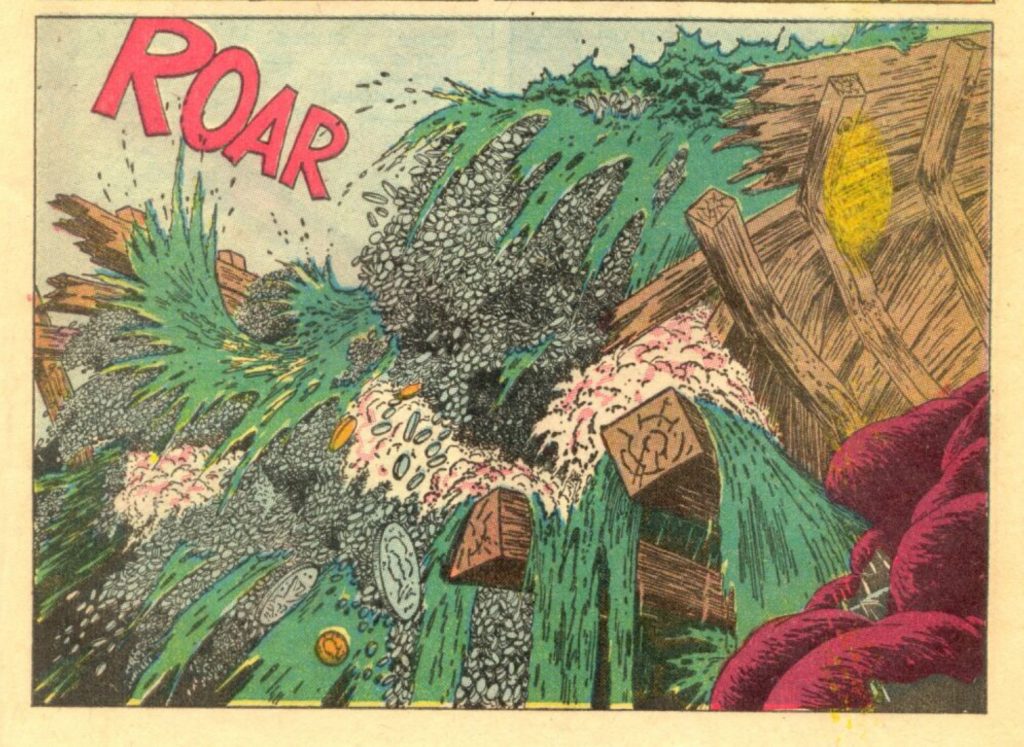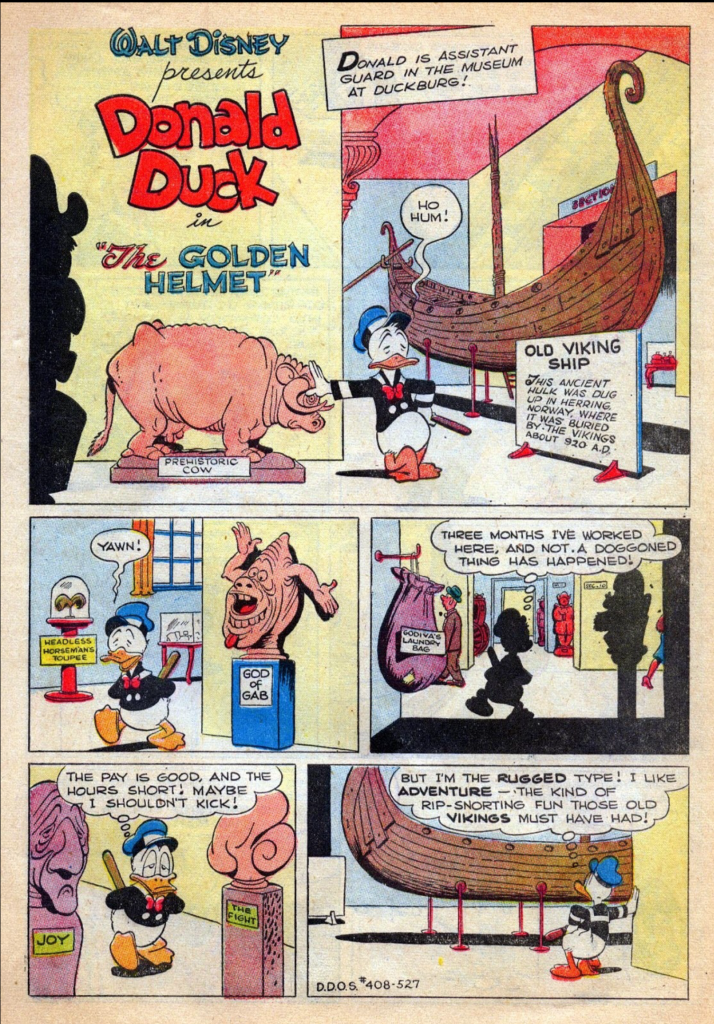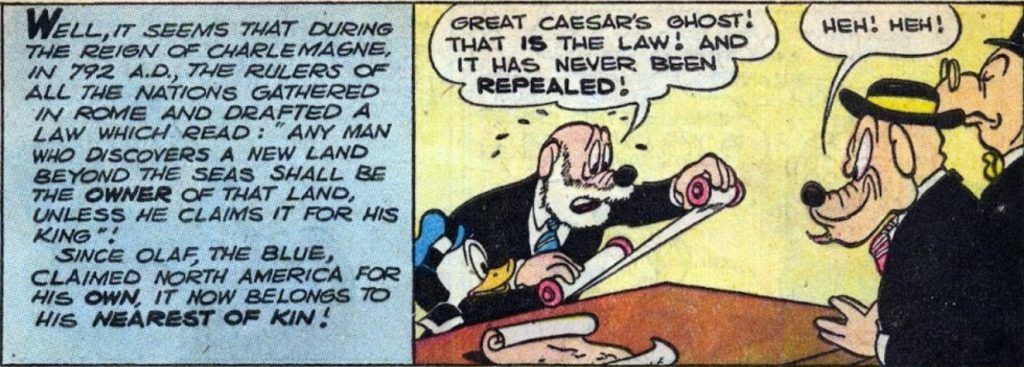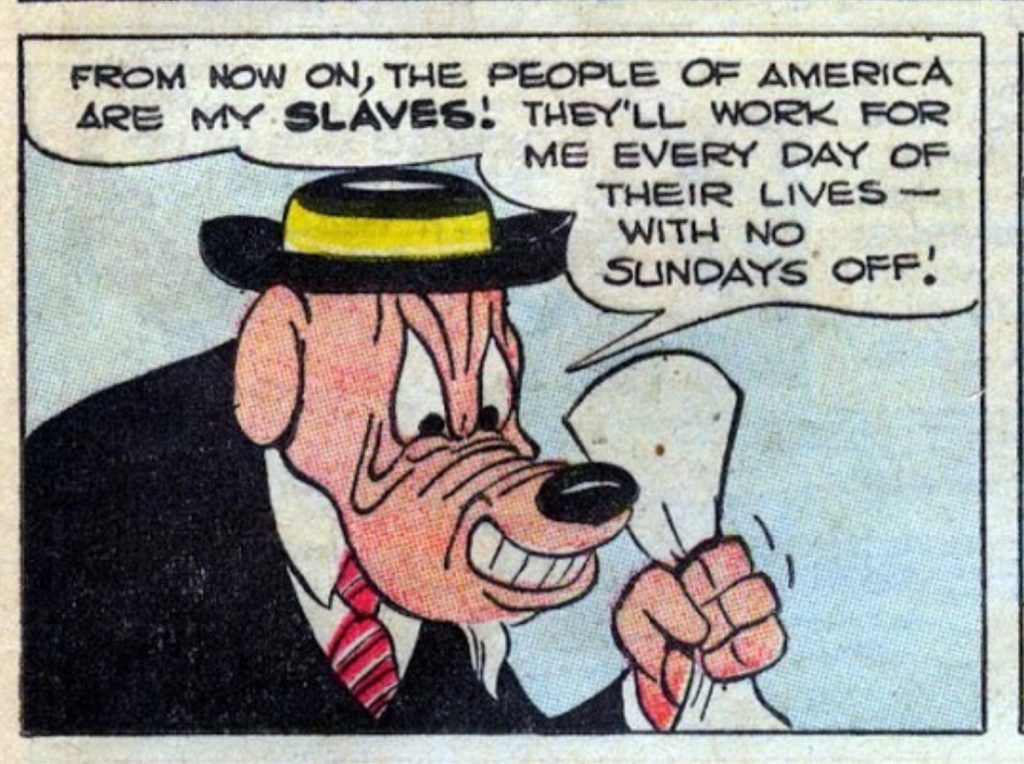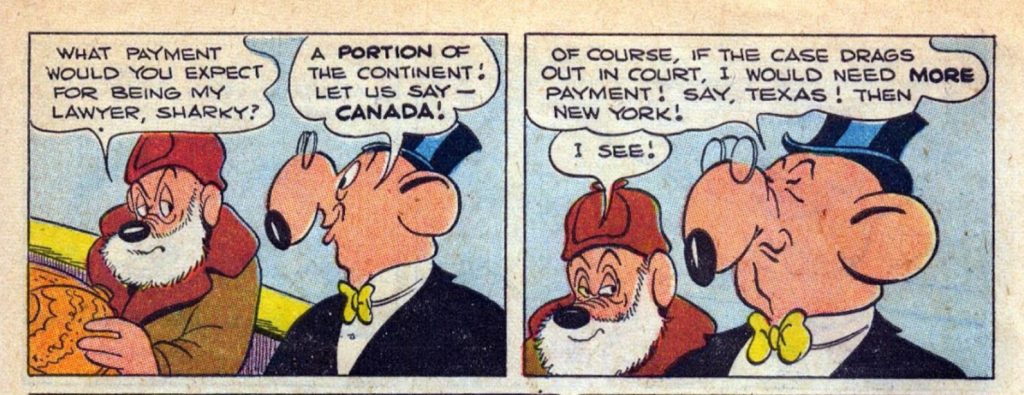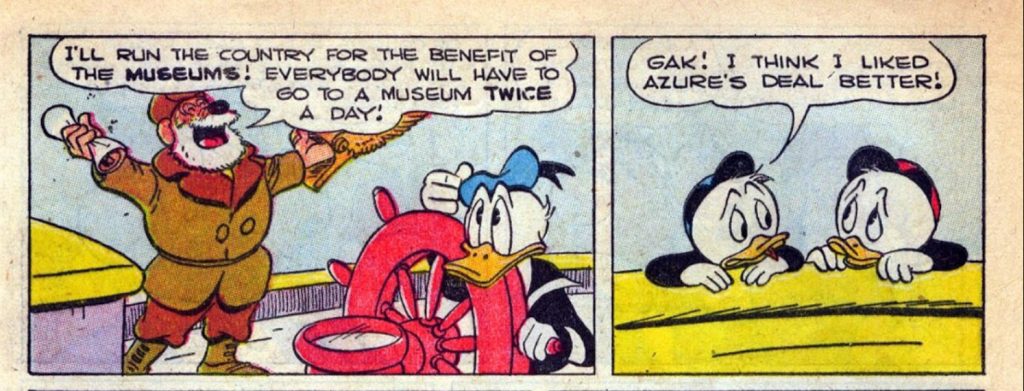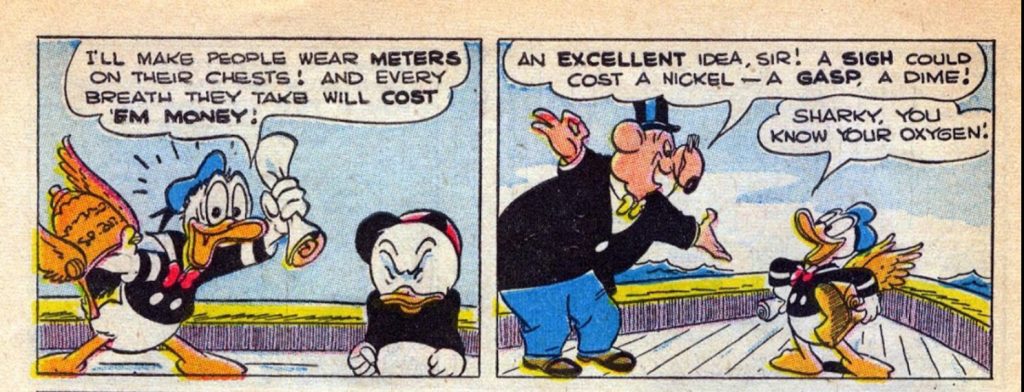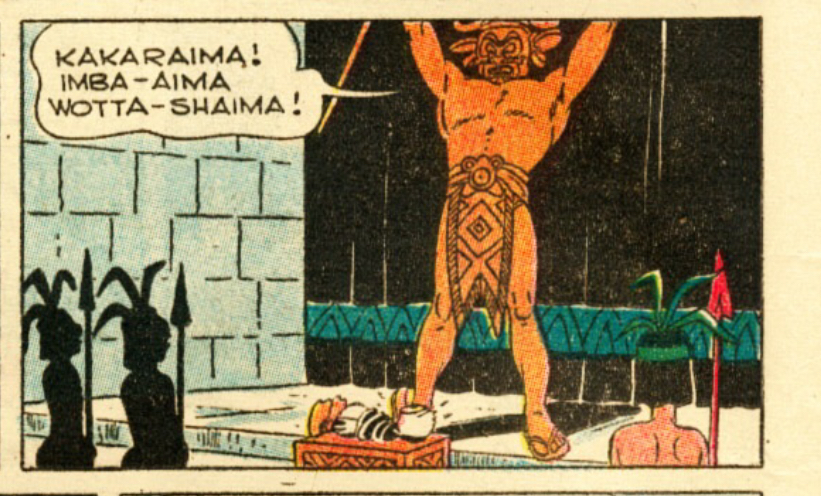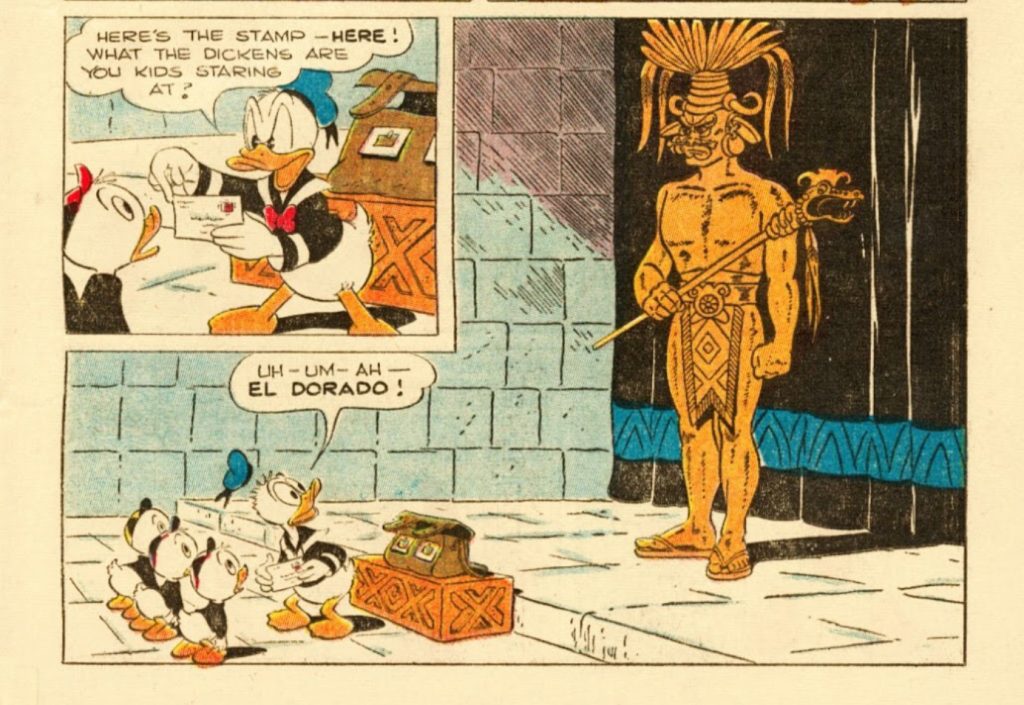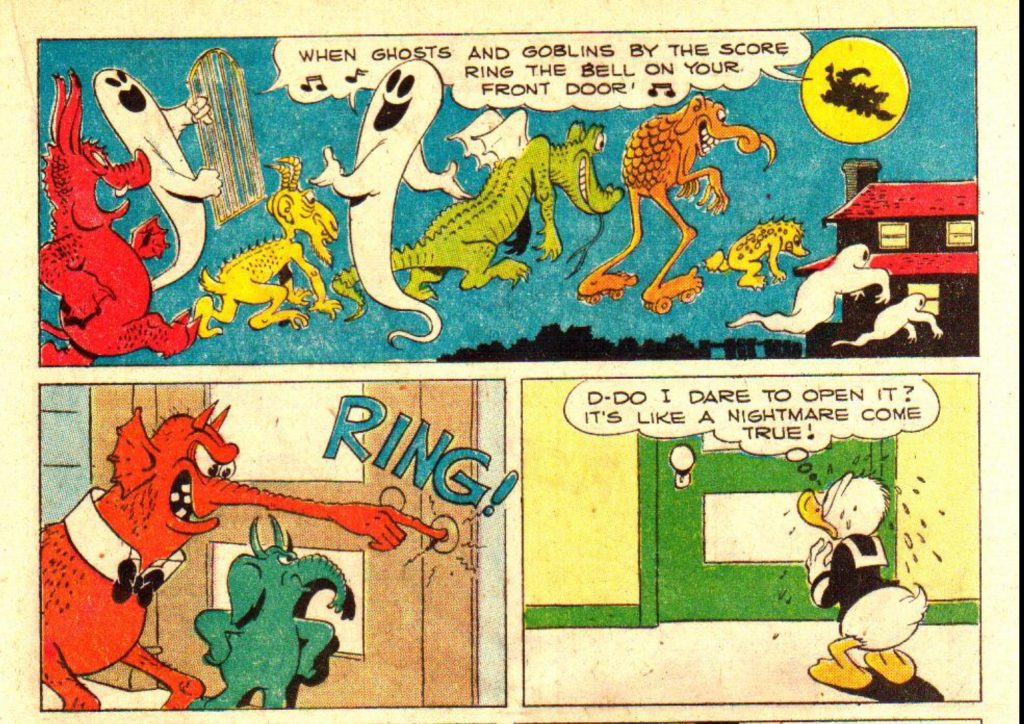I read Carl Barks’ work voraciously ever since I learned of the existence of the Disney comics and that Gemstone was reviving them in 2003, the year I turned ten. My grandpa and I drove to every comic shop in town to find a copy, starting a tradition we’d continue through my teen years and shift to superheroes and art-comix.
So why am I waiting until four years (FUCK) into this Year of the Month project to dig into his work? Well, 1952 was an unusually high point in Barks’ career. His most famous creation, Uncle Scrooge, got his first moment in the spotlight with the classic Only a Poor Old Man. It’s also the year of two of Barks’ greatest book-length adventure stories: The Gilded Man and The Golden Helmet, not coincidentally, two of the stories li’l me read and reread incessantly.
Making Uncle Scrooge a hero posed some obvious problems for Barks. How exactly do you get readers to side with the richest duck in the world, so rich Barks had to invent new numbers (fantasticillion, impossibidillion) just to describe his wealth? As any of the comments on Richie Rich on this very site should tell you, other comics creators have tried and failed. It’s no wonder Ariel Dorfman and Armand Mattelart read the Uncles Scrooge comics as capitalist propaganda in their essential study How to Read Donald Duck (more on that later; watch this space).
In a way, Scrooge was a victim of his own success. Bark originally conceived him as a hateful old miser like his namesake. But either in spite or because of that, readers loved him. So in some ways, whatever ideology these comics have is forced on them by circumstance, and since Barks obviously didn’t take them too seriously, it can be hard to parse. The opening has a lot of fun skewering paranoid Scrooge while he lectures Donald on how he needs money for security (with some prime deadpan absurdity as he muses “Worst year for moths I ever saw” while reloading an oversized blunderbuss):
But in the end, Scrooge, now that he’s a hero, gets the last laugh.
In his Donald Duck stories from this year, Barks continues on his merry way with Asshole Scrooge, most memorably in one story where he has so much money it’d cost more than it’s worth to reinforce his Money Bin (introduced a year earlier) to store it all. Against his best wishes, he pays Donald to spend the excess, and after the most miserable week of his life, he learns that he has his finger in so many pies that every cent he spent ended up right back with him.
Later stories would go even more back and forth on Scrooge. Beginning with this one, Barks stacked the deck to make Scrooge more likable with occasional references to his origins as a self-made man who rose from poverty through hard work:
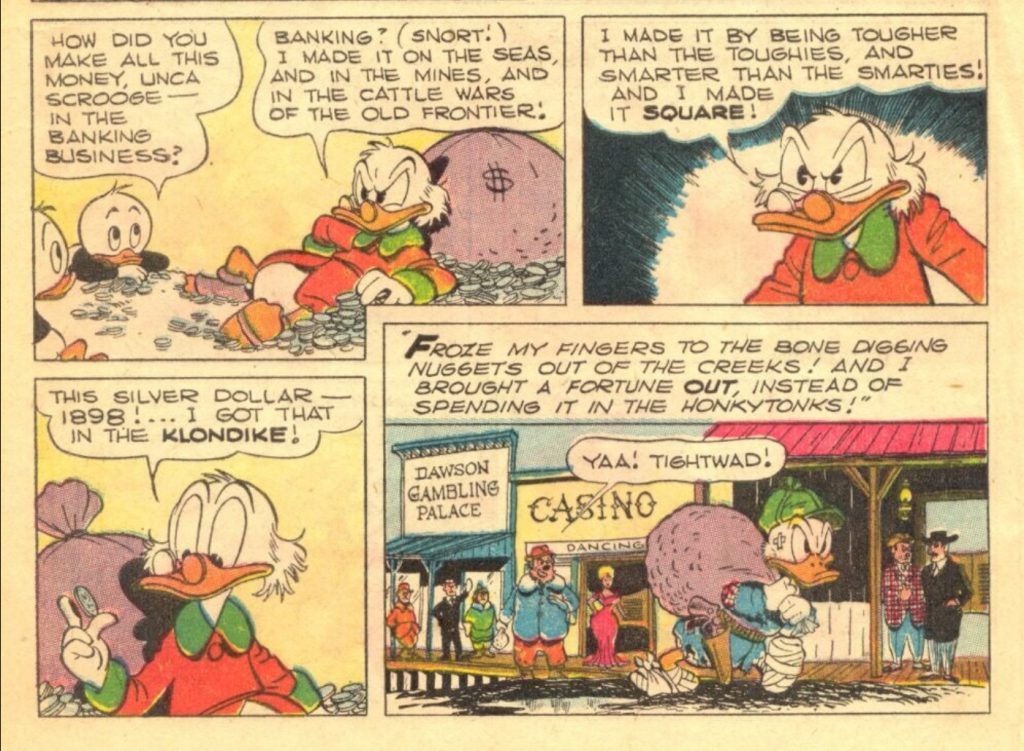
Later stories would look like right-wing screeds, with Barks portraying the activists asking Scrooge for donations as greasy freeloaders as the comics entered the hippie era. But then Barks himself started looking like a hippie in his final Junior Woodchucks stories where Scrooge plays the villain as an evil, polluting tycoon.
If the content’s muddled, the form is wonderful in its clarity. Everything in Barks’ comics is ludicrous, but still thought-out and unexpectedly plausible. In one story, Donald and his nephews raise a sunken boat with ping pong balls, and not only has that method worked in real life, the pre-existence of the story famously blocked a later inventor from patenting the method.
As The Beagle Boys once again try to plunder Scrooge’s Money Bin, Barks comes up with this kind of logical illogic to keep the story moving — as the Beagles dig foundations for a new building next to the bin so they can rob it, Scrooge sneaks the money out by hiding it in the Beagles’ own trucks as they dump the dirt into the river. Then the Beagles burst the dam with termites in a lovingly detailed image that kicks the ass of any “realistic” comic art of the time, never mind Barks’ cartoon competitors:
But that’s nothing next to The Golden Helmet. It opens with Donald as a museum guard, giving Barks a chance to go hogwild with his Mad-before-Mad background gags:
Donald discovers a strange man nosing around a Viking ship and finds what he was looking for, an ancient map from Viking explorer Olaf, the Blue (who “sailed the ship to Iceland years before Eric, the Red!”). The strange man turns out to be Olaf’s descendant Azure Blue, who claims ownership of the continent thanks to…well, let’s let Barks explain:
This is, of course, ridiculous, but no more so than the “codes of discovery” that have been used to establish European rule over people who’d been living in “new worlds” for millennia. The commentary may or may not be intentional here, but it certainly is in Hispanic writer Don Rosa’s sequel, The Lost Charts of Columbus, which ends with Huey, Dewey, and Louie re-examining one of the ancient maps they’ve discovered…
Either way, Barks treats his nonsense narrative catalyst with such conviction and impeccable little-kid logic that you can’t help but go along with it (full disclosure, I never realized how ridiculous this was all through my childhood). It’s maybe the best example of Barks’ ability to make these ridiculous conceits even more hilarious by treating them with a totally straight face — Dorfman compared Barks to Lewis Carrol, and he’s not wrong. To prove his claim, Azure Blue needs Olaf’s golden helmet, so Donald, his nephews, and the museum curator are off to beat him to it
They say a story’s only as good as its villain, and Azure Blue’s a great one. The basis of his threat may be ridiculous, but he never is, and whenever he’s on the page, The Golden Helmet turns from a kiddie adventure story to an adult thriller — he even pulls a gun to get his skittish captain to continue through a storm, and there’s no question whether he’s bluffing. Barks understands that cartoon exaggeration has more uses than just comedy and Azure’s a caricature of raw hatred, distilled into an almost Platonic form, silly and unsettling all at once.
The story gets funnier, but even darker, when the curator “crowns” Azure with a rock. You’d think that’d be the end of it. But then Azure’s slimy lawyer Sharkey (who Barks literally draws as a rat) turns Mephistopheles and tempts first the curator, and then Donald himself into claiming the helmet and the continent. There’s more examples of hilariously twisted Barks-logic here:
But it can also be downright chilling, especially for kids who’ve grown to identify with their cartoon hero. He may be even more ruthless than Azure Blue, abandoning his nephews on an iceberg so they can’t challenge his rule. “The thing that is most important about my comics is this,” Barks said, “I told it like it is. I told the kids that the bad guys have a little good in them and the good guys have a lot of bad in them, and that you couldn’t depend on much, and that nothing was going to always turn out roses. … It was the way life goes. I just didn’t disguise anything or make things rosy.” Through adult eyes, that may seem wide of the mark. But compared to the sentimental crap he shared the racks with, Barks is practically a nihilist.
He was also unpredictable. Over the course of his career, Barks sent Donald and Scrooge after all the great legendary treasures — the golden fleece, the Fountain of Youth, and so on. So it was inevitable he’d go after El Dorado, the mother of them all. But instead of the golden city we’ve all seen a million times, in The Gilded Man, Barks went to an older, more obscure variant of the legend, where El Dorado wasn’t a city, but a man who covered himself in gold dust (which was still appealing to treasure hunters, who searched for the pool where he washed it off after each ceremony).
And The Gilded Man isn’t really even about that — Donald takes care of El Dorado in a couple pages. Barks discovered another treasure, more mundane but so valuable the ducks completely ignore the legendary priest-king: the French Guianan penny magenta stamp, the rarest and most valuable in the world. They learn where they can find it from an old man whose father lost it in El Dorado’s city long ago, after they rescue him from some piranhas in 1952’s most hilarious example of Barks-logic:
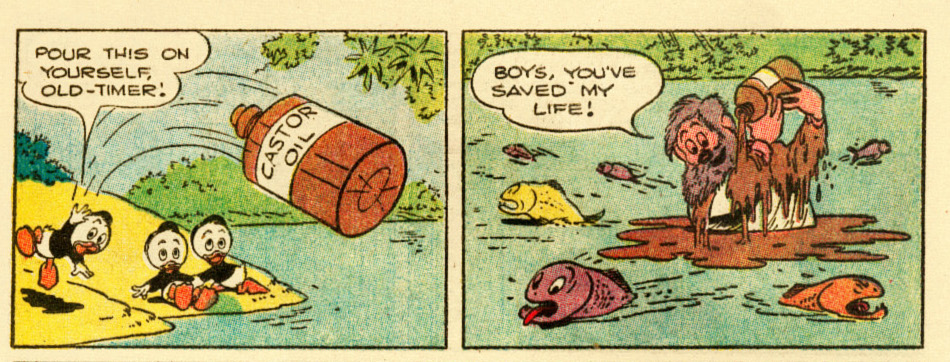
There’s some commentary on the arbitrariness of value there, and it continues when the Ducks finally find the stamp — the Ducks discover it in an antique mailbag El Dorado stole for its silver buckles, worthless outside but a valuable rarity in the golden city.
Barks can’t see beyond certain other prejudices, unfortunately, and his version of indigenous people is about as bad as you’d expect. Their appearance is a mishmash of “savage” signifiers that sometimes come from the wrong continent entirely, and their language is gibberish wordplay, which it gives me no joy to tell you is actually pretty clever.
At least it’s not as bad as Little Hiawatha over in Walt Disney’s Comics and Stories.
And Barks stands out above his peers in his storytelling here. Most of them used rigid panel grids, but Barks sees more potential in the medium, leaning on them just enough that it’s shocking when he rebuilds them around the needs of the story, like the shocking scene where he emphasizes the monumental power of El Dorado by literally warping the page around him so he can fit.
Barks’ final book-length story for the year is an adaptation of the recent animated short Trick or Treat. It’s an odd choice for the comic treatment. The original cartoon has very little plot (Donald pranks nephews and witch on Halloween, witch and nephews get back at him, get their candy) and a whole lot of music, which Barks crudely translates to the page. But he also shows more imagination than the whole Disney crew, replacing their generic ghosts with a whole menagerie of vividly realized creepies.
He also expanded the story with new sequences where the witch pulls a Bugs Bunny seduction gambit and summons this wonderfully designed whatsit.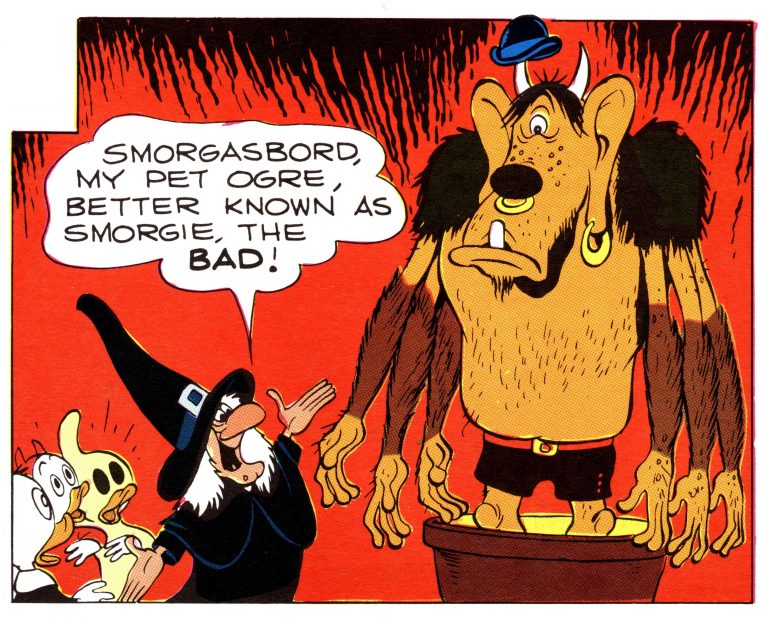
But the very same higher-ups who commissioned Barks to expand the short into a full-length comic complained that he’d expanded it too much and cut the new sequences, forcing Barks to come up with a backup story to fill out the book. Obviously, the good artist wasn’t working in an environment that encouraged creativity. That only makes the creativity of his comics that much more astonishing.
These comics are available from Fantagraphics in The Complete Carl Barks Library Volumes 11-13: Christmas for Shacktown, Only a Poor Old Man, and Trick or Treat, currently 50% off on Comixology; The Golden Helmet is also available on its own

